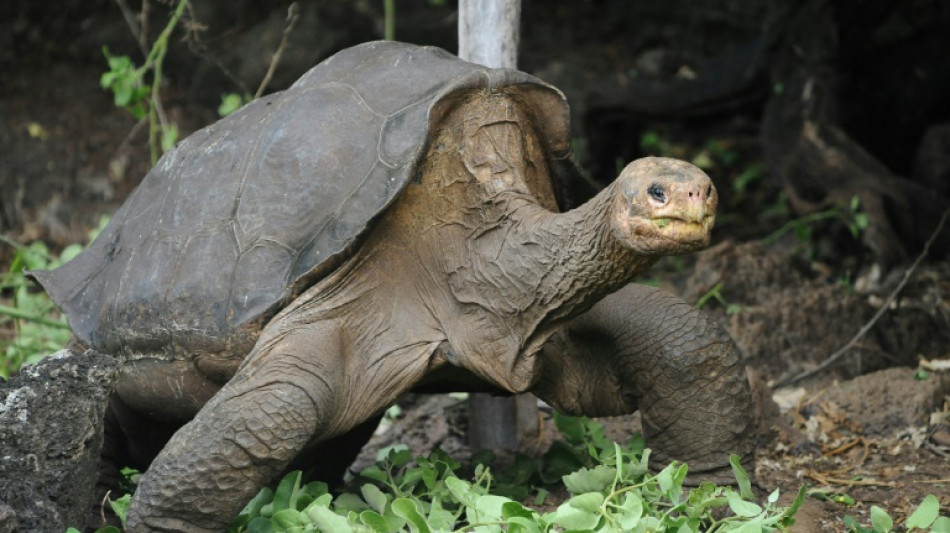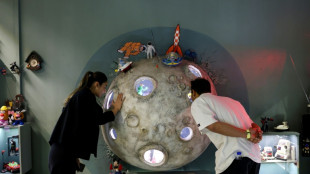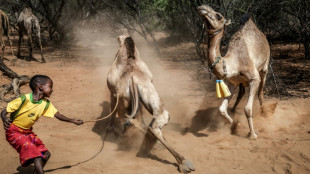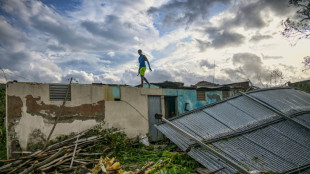
-
 India hails maiden women's World Cup cricket title as game-changer
India hails maiden women's World Cup cricket title as game-changer
-
As clock ticks down, Greece tries to clean up its act on waste

-
 Local fabrics, fibres shine at eco-centred Lagos Fashion Week
Local fabrics, fibres shine at eco-centred Lagos Fashion Week
-
Spalletti bidding to revive Juve and reputation ahead of Sporting visit in Champions League

-
 Tanzania president to be inaugurated as opposition says hundreds dead
Tanzania president to be inaugurated as opposition says hundreds dead
-
Bouanga brace as LAFC beats Austin 4-1 to advance in MLS Cup playoffs

-
 'Golden age': Japan hails Yamamoto, Ohtani after Dodgers triumph
'Golden age': Japan hails Yamamoto, Ohtani after Dodgers triumph
-
Thunder roll over Pelicans to remain NBA's lone unbeaten team

-
 Hong Kong legislature now an 'echo chamber', four years after shake-up
Hong Kong legislature now an 'echo chamber', four years after shake-up
-
Most Asian markets rise on lingering trader optimism

-
 Andrew to lose his last military rank: defence minister
Andrew to lose his last military rank: defence minister
-
Trump's global tariffs to face challenge before Supreme Court

-
 Barnstorming Bayern face acid test at reigning champions PSG
Barnstorming Bayern face acid test at reigning champions PSG
-
Alonso shaping new Real Madrid on Liverpool return

-
 Half Yours favourite at Australia's 'race that stops a nation'
Half Yours favourite at Australia's 'race that stops a nation'
-
Tonga rugby league star has surgery after 'seizure' against NZ

-
 Trent's return with Real Madrid reminds Liverpool of what they are missing
Trent's return with Real Madrid reminds Liverpool of what they are missing
-
Tehran toy museum brings old childhood memories to life

-
 Iran banking on Iraq vote to retain regional influence
Iran banking on Iraq vote to retain regional influence
-
Daughter of 'underground' pastor urges China for his release

-
 Trump the Great? President steps up power moves
Trump the Great? President steps up power moves
-
Fire ravages French monastery dubbed 'Notre-Dame of the Ardennes'

-
 Bills outlast Chiefs while NFL-best Colts fall to Steelers
Bills outlast Chiefs while NFL-best Colts fall to Steelers
-
NBA champion Thunder roll over Pelicans to remain unbeaten

-
 Eliud Kipchoge unveils plan to run 7 marathons on 7 continents
Eliud Kipchoge unveils plan to run 7 marathons on 7 continents
-
Milan deny Roma top spot in Serie A, Inter beat Verona

-
 Lens back up to third in Ligue 1 as Lyon held at Brest
Lens back up to third in Ligue 1 as Lyon held at Brest
-
NFL-best Colts fall to Steelers, Packers lose to Carolina

-
 'Regretting You' wins spooky slow N. American box office
'Regretting You' wins spooky slow N. American box office
-
'Just the beginning' as India lift first Women's World Cup

-
 Will Still sacked by struggling Southampton
Will Still sacked by struggling Southampton
-
Malinin wins Skate Canada crown with stunning free skate

-
 Barca beat Elche to recover from Clasico loss
Barca beat Elche to recover from Clasico loss
-
Jamaica deaths at 28 as Caribbean reels from colossal hurricane

-
 Verma and Sharma power India to first Women's World Cup triumph
Verma and Sharma power India to first Women's World Cup triumph
-
Auger-Aliassime out of Metz Open despite not yet securing ATP Finals spot

-
 Haaland fires Man City up to second in Premier League
Haaland fires Man City up to second in Premier League
-
Sinner says staying world number one 'not only in my hands'

-
 Ready for it? Swifties swarm German museum to see Ophelia painting
Ready for it? Swifties swarm German museum to see Ophelia painting
-
Pope denounces violence in Sudan, renews call for ceasefire

-
 Kipruto, Obiri seal Kenyan double at New York Marathon
Kipruto, Obiri seal Kenyan double at New York Marathon
-
OPEC+ further hikes oil output

-
 Sinner returns to world number one with Paris Masters win
Sinner returns to world number one with Paris Masters win
-
Sinner wins Paris Masters, reclaims world No. 1 ranking

-
 Nuno celebrates first win as West Ham boss
Nuno celebrates first win as West Ham boss
-
Obiri powers to New York Marathon win

-
 Two Louvre heist suspects a couple with children: prosecutor
Two Louvre heist suspects a couple with children: prosecutor
-
Verma, Sharma help India post 298-7 in Women's World Cup final

-
 Inter snapping at Napoli's heels, Roma poised to pounce
Inter snapping at Napoli's heels, Roma poised to pounce
-
India space agency launches its heaviest satellite


Extinct-in-the-wild species in conservation limbo
For species classified as "extinct in the wild", the zoos and botanical gardens where their fates hang by a thread are as often anterooms to oblivion as gateways to recovery, new research has shown.
Re-wilding what are often single-digit populations faces the same challenges that pushed these species to the cusp of extinction in the first place, including a lack of genetic diversity. But without conservation efforts, experts say, chances of these species surviving would be even smaller.
Since 1950, nearly 100 animal and plant species vanquished from nature by hunting, pollution, deforestation, invasive lifeforms and other drivers of extinction have been put into critical care by scientists and conservationists, according to the findings.
While the category "extinct in the wild" was not added to the benchmark Red List of Threatened Species until 1994, the term could have applied to all of them.
Of these species teetering on the edge, 12 have been reintroduced to some degree back into the wild, according to a pair of studies published last week in the journals Science and Diversity.
Another 11, however, have gone the way of dinos, dodos and dozens of Pacific island trees, whose delicate flowers will never again grace the planet.
Biodiversity loss has reached crisis proportions not seen since an errant asteroid as big across as Paris smashed into Earth 66 million years ago, wiping out land dinosaurs and ending the Cretaceous period.
That was one of five so-called mass extinction events over the last half-billion years.
Scientists say human activity has pushed Earth into the sixth, with species disappearing 100 to 1,000 times more quickly than normal.
"Real opportunities to prevent extinction and return previously lost species to the wild abound and we must take them," the international team of 15 authors said.
"We have lost 11 species entirely under our care to extinction since 1950."
- Success stories -
Another study published last week in Current Biology -- looking at the "Great Dying" event 252 million years ago that annihilated 95 percent of life on Earth -- showed that accelerated species loss preceded broader ecological collapse.
"Currently, we may be losing species at a faster rate than in any of Earth's past extinctions," lead author Yuangeng Huang, a researcher at the China University of Geosciences, told AFP.
"We cannot predict the tipping point that will send ecosystems into a total collapse but it is an inevitable outcome if we do not reverse biodiversity loss."
Recent conservation success stories -- some of them heroic -- include the European bison, which once roamed across Europe.
By the 1920s their numbers were so reduced that surviving specimens were rounded up into zoos and a breeding programme was launched in Poland.
After reintroduction into the wild in 1952, the broad-shouldered beasts thrived and are no longer considered threatened with extinction by the Internation Union for the Conservation of Nature (IUCN), the keepers of the Red List.
Red wolves in North America, wild horses in central Asia and the desert-dwelling Arabian oryx have all staged comebacks with a helping human hand.
So has the largest land tortoise in the world, native to Espanola Island in the Galapagos.
By the 1970s, Chelonoidis hoodensis had been eaten to the brink. Fourteen surviving individuals were removed and relocated decades later to another island, where their numbers are increasing.
- 'Overlooked category' -
Giant Pinta tortoises on a neighbouring Galapagos island -- one of the 11 extinct-in-the-wild species that didn't make it -- were not so lucky.
After living for half a century as his species' sole survivor, a 75-kilogramme (165-pound) male known as Lonesome George died in 2012.
Other creatures that never made it out of intensive care include Hawaii's black-faced honey creeper, a petite bird devastated by mosquito-borne avian malaria last seen in 2004; Mexico's freshwater Catarina pupfish, unsuccessfully relocated to captivity when its native habitat dried out due to groundwater extraction; and five types of snail on the Society Islands that fell victim to an invasive carnivorous cousin.
Surprisingly, the studies show that species surviving only in controlled environments are in a kind of conservation limbo.
"This is an overlooked category," the researchers noted.
"Despite being considered most at risk, extinct-in-the-wild species are not assessed under the Red List process."
"We have largely ignored the extent of, and the variation in, extinction risk of the very group of species for which humans are most responsible," they added.
Of the 84 species currently with this status, nearly half have not benefitted from attempts to reintroduce them into the wild. Most are plants, suggesting a possible bias towards reintroducing animals that might not be entirely scientifically justified.
At its most recent World Conservation Congress in 2020, the IUCN called for the reestablishment of extinct-in-the-wild species in the wild by 2030.
Y.Bouchard--BTB




